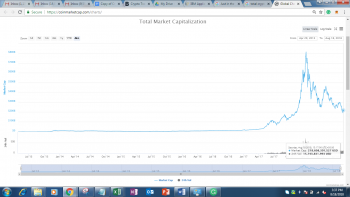The report titled ‘Crypto Trading–The Next Big Thing is Here’ from Sanford C. Bernstein & Co. shows that crypto exchanges have the potential to more than double their revenues as much $4 billion in 2018.
Crypto Trading Revenue Growth
In 2017, buying and selling of cryptocurrencies generated revenue to the tune of $1.8 billion in transaction fees. In percentage terms, this is about eight percent of the revenue reported on traditional exchanges.
According to CoinMarketCap, the aggregate market capitalization of all virtual currencies has grown meteorically from $17.7 billion at the start of 2017 to a whopping $218 billion as of August 18, 2018.

(Source: CoinmarketCap)
This growth in trading and market capitalization has generated lots of revenue in transaction fees. In case you are curious to know the makeup of the transaction fees, below is a breakdown of the major classes of transaction fees.
Exchange Fees
This is the commission paid to exchange to complete a sell or buy order. The fee may vary per exchange, but the most common model is the fixed-fee format. In some crypto exchanges, the maker-taker model is used where the fee varies depending on the trading activity.
Network Fees
This transaction fee is paid to the cryptocurrency miners to incentivize them. These are the people responsible for verification and validation of transactions before being added to the blockchain. The exchanges may at their will charge a network fee higher than what they pay to miners to net them some profit.
Wallet Fees
You pay these fees to your digital wallet provider to cover part of their development costs, regular updates, and crypto storage services. Institutional clients are likely to pay big chunks for custodial services.
The Rise in Crypto Trading Activities
Estimates compiled by Bloomberg show that the trading volume of the top ten cryptocurrencies totals to about $3 million in fees daily. Since the revenue comes from the increased trading activities on crypto exchanges, it helps to know why these markets are increasingly bullish.
BTCManager reported in July 2018, that Binance is all set to earn up to $1 billion in 2018. It’s evident from the numbers that despite bear markets, the house will keep winning.
Save for global cash equity segments such as US equities, European equities, and US corporate date, cryptocurrencies continue to outperform traditional assets. Naturally, this endears them to risk-seeking investors.
Blockchain technology, that powers a majority of cryptocurrencies, continues to become a decentralized platform that in turn eliminates third parties. This makes it cheaper and more efficient in asset exchange.
Even with the vibrancy in the crypto market, some investors are still cautious. This is mainly because of price volatilities and uncertainties arising from government regulations. For instance, bitcoin lost nearly three-quarters of its value from December 2017.
Coinbase, a San Francisco-based crypto exchange platform established in June 2012 is the biggest of all exchanges in revenue generation. Currently, it accounts for about 50 percent of all transaction fee revenue. One of the factors behind the success is the fact that it is backed by venture capital, traditional banks, and exchanges.
At this rate of growth and general acceptance of cryptocurrencies globally, crypto revenues will continue growing and surpass by far most traditional asset classes.







